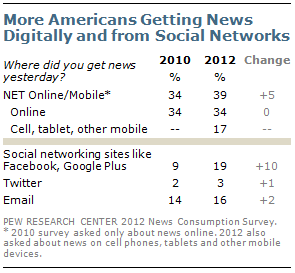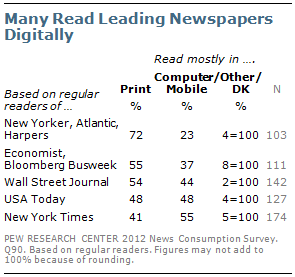
Newspaper progress bar.
We’ve talked about disruptive innovation on this blog, and how print media going digital is shaping the industry and affecting news reporters in particular. With two newly released reports providing data on the shifting trends in print journalism, let’s look from a PR/newsblogging angle at how your company or brand might benefit.
A recent article, “How shifting newspaper circ numbers affect PR pros,” by communications expert Gil Rudawsky points out five distinct trends based on the semiannual newspaper FAS-FAX and Audience-FAX report released Oct. 30 by the Alliance for Audited Media, formerly known as the Audit Bureau of Circulations. The agency’s report provides circulation data for its newspaper members for the six months ending on Sept. 30, 2012, and includes both print and digital data.
The report’s key findings included the following:
Daily circulation for the 613 U.S. newspapers reporting comparable multiday averages decreased 0.2 percent. Circulation for the 528 newspapers reporting comparable Sunday data increased 0.6 percent.
On average, digital circulation now accounts for 15.3 percent of newspapers’ total circulation mix, up from 9.8 percent in September 2011. Digital circulation may be tablet or smartphone apps, PDF replicas, metered or restricted-access websites, or e-reader editions.
The Wall Street Journal topped the list of the 25 leading U.S. dailies (1,499,204 print edition, 794,594 digital), followed by USA TODAY (1,627,526/86,307), and The New York Times (717,513/896,352). Notably, the NYT is the only newspaper on the list with the digital-edition number bigger than the print one (also see the Pew Research Center’s survey results, below).
And, illustrating that “digital first” and paywalls do work, the top five of the 25 U.S. daily newspapers with digital editions are: The New York Times, The Wall Street Journal, New York Post, Denver Post, and Los Angeles Times.
With these numbers in mind, Rudawsky concludes that “Fewer people are reading actual newspapers, but the dwindling numbers continue to be offset by the growing market of digital subscribers.” The shift, he writes, means this to a PR pro:
- Clients must be convinced that coverage in digital editions is just as good as, if not better than, that in print editions.
- Newspapers no longer have a monopoly on the news, and their online sites even the playing field with all online-only news outlets.
- Digital-only news sites will continue to offer us more opportunities because they are not saddled with paper and delivery costs.
- Expect more paywalls and intrusive banner ads as newspapers seek to capture digital dollars.
- You cut costs by getting rid of newspaper clipping services.
“The story behind the numbers is that paywalls aren’t just a passing fad, but a possible way to save news outlets that continue to buy ink by the barrel, he says, “Although it’s still unclear whether the digital subscribers will rescue the industry.”
Alyshia Kisor-Madlem, in her Nov. 13 article on PR Daily, quotes Pew Research Center’s biennial news consumption survey results, offering her own conclusions on what the shift to online media means to the PR industry (and the client).
Pew’s report, released on Sept. 27, 2012, highlights trends in the U.S. news consumption from 1991 to 2012, noting that “transformation of the nation’s news landscape has already taken a heavy toll on print news sources, particularly print newspapers. […] Online and digital news consumption, meanwhile, continues to increase, with many more people now getting news on cell phones, tablets or other mobile platforms.”

The report’s numbers are telling:
The percentage of Americans saying they saw news or news headlines on a social networking site yesterday has doubled — from 9% to 19% — since 2010. Among adults younger than age 30, as many saw news on a social networking site the previous day (33%) as saw any television news (34%), with just 13% having read a newspaper either in print or digital form.
The proportion of Americans who read news on a printed page — in newspapers and magazines — continues to decline, even as online readership has offset some of these losses. Just 23% say they read a print newspaper yesterday, down only slightly since 2010 (26%), but off by about half since 2000 (47%).
While Americans enjoy reading as much as ever — 51% say they enjoy reading a lot, little changed over the past two decades — a declining proportion gets news or reads other material on paper on a typical day. […]
Over the past decade, the percentage reading a print newspaper has fallen by 18 points (from 41% to 23%). Somewhat more (38%) say they regularly read a daily newspaper, although this percentage also has declined, from 54% in 2004. […]

So, based on the data, Kisor-Madlem outlines seven ways a company or a brand can benefit from using online media vs. print:
- Earned media begets owned media
A piece of earned media, such as a product feature on an online site, can now be used to help shape and create owned media, including client blogs, tweets, and Facebook posts. High-quality and timely earned-media that is paired with the delivery of well-crafted owned media can elevate brand awareness to the next level…- Tracking tactics
With the advent of Google Analytics, tracking the results of an integrated social media and PR campaign has become easier.- It’s a numbers game
A large majority of online outlets have higher circulations than traditional print publications. […] [O]nline coverage has the potential for more eyeballs to be exposed to their product and brand, and for a longer period of time.- Content. It lives!
… [Y]our client’s coverage reaches a broader audience and can be shared and disseminated often and widely.- SEO-tastic
Online media removes that middleman, placing hyperlinks directly to a client’s home page, product page, or blog, in the body of the article.- Integration of assets
Articles in a print publication are limited in the type of assets they can incorporate. […] With online features, you have ability to share other assets you have created, such as slideshows and videos…- Constant content
Unlike magazines that tend to be released monthly and newspapers that come out daily or weekly, online outlets are constantly looking to generate and update content.
The numbers paint a pretty clear picture that the print media can successfully go digital — partially or all the way — and other businesses and brands can follow and take advantage of the changing landscape.
Image (top) by Rev Dan Catt (Daniel Catt).